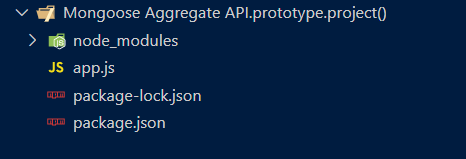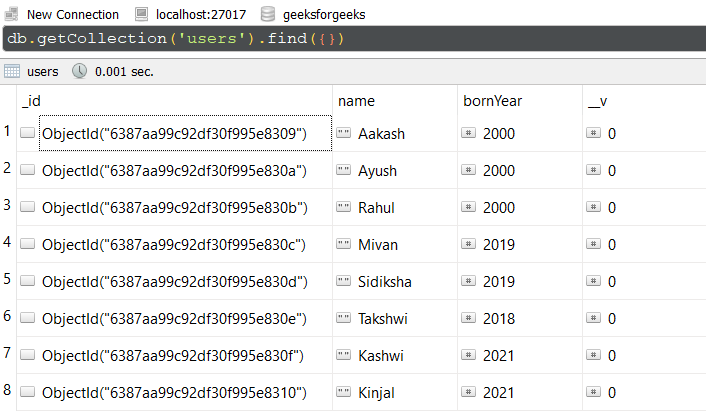Mongoose API 的 Aggregate API.prototype.project() 方法用于执行聚合任务。它允许我们从集合中选择字段。使用此方法,我们可以请求将选定的字段从集合中提取到结果集中。如果您不希望集合中的所有字段都包含在结果集中,可以使用project()请求将指定字段包含在结果集中。总的来说,我们可以为结果集指定包含字段和排除字段。
句法:
aggregate().project( specifications )
参数:此方法接受单个参数,如下所述:
- Object/String: 它用于指定要在结果集中包含和排除的字段。
返回值:该方法以数组的形式返回结果集。
设置 Node.js Mongoose 模块:
步骤 1:使用以下命令创建 Node.js 应用程序:
npm init
步骤 2:创建 NodeJS 应用程序后,使用以下命令安装所需的模块:
npm install mongoose
项目结构: 项目结构将如下所示:

数据库结构:数据库结构如下所示,集合中存在以下文档。

示例 1:在此示例中,我们使用 mongoose 建立了数据库连接,并通过 userSchema 定义了模型,具有三个列或字段 “_id”、“name” 和 “bornYear”。最后,我们呼吁project()方法通过以对象的形式传递规范。在这个例子中,我们想要_id和名字包含在结果集中。这就是为什么我们将它们的值设置为1。如果您不希望任何字段包含在结果集中,则可以不在规范中提及它,也可以指定0 作为该字段的值。
文件名:app.js
Javascript
// Require mongoose module
const mongoose = require("mongoose");
// Set Up the Database connection
mongoose.connect("mongodb://localhost:27017/geeksforgeeks", {
useNewUrlParser: true,
useUnifiedTopology: true,
});
const userSchema = new mongoose.Schema({
name: String,
bornYear: Number
});
const User = mongoose.model('User', userSchema);
User.aggregate()
.project({ _id: 1, name: 1 })
.then((result, error) => {
if (result)
console.log(result);
else
console.log(error)
})运行程序的步骤:要运行应用程序,请从项目的根目录执行以下命令:
node app.js
输出:
[
{ _id: new ObjectId("6387aa99c92df30f995e8309"), name: 'Aakash' },
{ _id: new ObjectId("6387aa99c92df30f995e830a"), name: 'Ayush' },
{ _id: new ObjectId("6387aa99c92df30f995e830b"), name: 'Rahul' },
{ _id: new ObjectId("6387aa99c92df30f995e830c"), name: 'Mivan' },
{ _id: new ObjectId("6387aa99c92df30f995e830d"), name: 'Sidiksha' },
{ _id: new ObjectId("6387aa99c92df30f995e830e"), name: 'Takshwi' },
{ _id: new ObjectId("6387aa99c92df30f995e830f"), name: 'Kashwi' },
{ _id: new ObjectId("6387aa99c92df30f995e8310"), name: 'Kinjal' }
]
示例 2:在此示例中,我们使用 mongoose 建立了数据库连接,并通过 userSchema 定义了模型,具有三列或字段 “_id”、“name” 和 “bornYear”,我们调用aggregate()用户模型上的方法。在这个例子中,我们只想要出生年份要包含在结果集中的字段。这就是为什么我们分配了1 到出生年份场和0 到_ID。我们没有提到过名字字段,因此它将自动被视为不包含在结果集中。
文件名:app.js
Javascript
// Require mongoose module
const mongoose = require("mongoose");
// Set Up the Database connection
mongoose.connect("mongodb://localhost:27017/geeksforgeeks", {
useNewUrlParser: true,
useUnifiedTopology: true,
});
const userSchema = new mongoose.Schema({
name: String,
bornYear: Number
});
const User = mongoose.model('User', userSchema);
User.aggregate([{ $project: { _id: 0, bornYear: 1 } }])
.exec((error, result) => {
if (error) {
console.log(error);
} else {
console.log(result);
}
})运行程序的步骤:要运行应用程序,请从项目的根目录执行以下命令:
node app.js
输出:
[
{ bornYear: 2000 },
{ bornYear: 2000 },
{ bornYear: 2000 },
{ bornYear: 2019 },
{ bornYear: 2019 },
{ bornYear: 2018 },
{ bornYear: 2021 },
{ bornYear: 2021 }
]
参考:https://mongoosejs.com/docs/api/aggregate.html#aggregate_Aggregate-project
相关用法
- Mongoose Aggregate.prototype.pipeline()用法及代码示例
- Mongoose Aggregate.prototype.catch()用法及代码示例
- Mongoose Aggregate.prototype.exec()用法及代码示例
- Mongoose Aggregate.prototype.model()用法及代码示例
- Mongoose Aggregate.prototype.skip()用法及代码示例
- Mongoose Aggregate.prototype.limit()用法及代码示例
- Mongoose Aggregate.prototype.then()用法及代码示例
- Mongoose Aggregate.prototype.append()用法及代码示例
- Mongoose Aggregate.prototype.sortByCount()用法及代码示例
- Mongoose Aggregate.prototype.match()用法及代码示例
- Mongoose Aggregate.prototype.cursor()用法及代码示例
- Mongoose Aggregate.prototype.sort()用法及代码示例
- Mongoose Aggregate.prototype.addFields()用法及代码示例
- Mongoose Aggregate.prototype.lookup()用法及代码示例
- Mongoose Aggregate prototype.unionWith()用法及代码示例
- Mongoose Aggregate prototype.sample()用法及代码示例
- Mongoose Aggregate prototype.unwind()用法及代码示例
- Mongoose countDocuments()用法及代码示例
- Mongoose deleteMany()用法及代码示例
- Mongoose deleteOne()用法及代码示例
- Mongoose estimatedDocumentCount()用法及代码示例
- Mongoose exists()用法及代码示例
- Mongoose find()用法及代码示例
- Mongoose findById()用法及代码示例
- Mongoose findByIdAndDelete()用法及代码示例
注:本文由纯净天空筛选整理自sakshio0hoj大神的英文原创作品 Mongoose Aggregate.prototype.project() API。非经特殊声明,原始代码版权归原作者所有,本译文未经允许或授权,请勿转载或复制。
